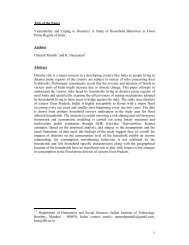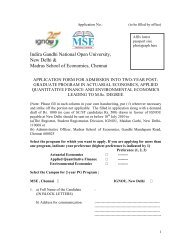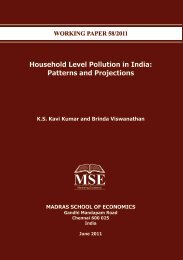Performance of Flagship Programmes in Tamil Nadu
Performance of Flagship Programmes in Tamil Nadu
Performance of Flagship Programmes in Tamil Nadu
Create successful ePaper yourself
Turn your PDF publications into a flip-book with our unique Google optimized e-Paper software.
the Government fold and evolved an <strong>in</strong>ternal monitor<strong>in</strong>g evaluation system, <strong>in</strong><br />
addition to an occasional external evaluation.<br />
(2) F<strong>in</strong>ancial allocation to <strong>Tamil</strong> <strong>Nadu</strong> under this scheme by the centre was Rs. 144<br />
crore <strong>in</strong> 2007-08 and <strong>in</strong>creased to Rs. 402 crore <strong>in</strong> 2009-10. At the same time,<br />
the expenditure <strong>in</strong>creased from Rs. 144 crore to Rs. 400 crore. Thus, the fund<br />
utilization ratio is almost 100 percent.<br />
(3) Egg and fruit are <strong>in</strong>troduced <strong>in</strong> the meal thrice a week. All students who wanted<br />
to avail <strong>of</strong> the meal <strong>in</strong> the school are served food. About 57.75 lakh students<br />
benefited from the scheme. More than 47 thousand schools implement the midday<br />
meal scheme for 220 days <strong>in</strong> a year. Of this, 39,282 are local body<br />
Government schools. The socially backward groups seem to have also benefited.<br />
(4) The <strong>in</strong>tervention <strong>of</strong> nutrious meal has reduced drop out rate at primary level to<br />
1.02 percent and at upper primary to 1.88 percent <strong>in</strong> 2009.<br />
(x) Sarva Shiksha Abhiyan<br />
(1) <strong>Tamil</strong> <strong>Nadu</strong> has been striv<strong>in</strong>g to achieve 100 percent literacy and the Sarva<br />
Shiksha Abhiyan programme has helped the state to also focus on education<br />
beyond the primary level.<br />
(2) Dur<strong>in</strong>g 2001-02 to 2009-10, the centre released Rs. 2,506 crore and the state<br />
released Rs. 1,140 crore under this scheme.<br />
(3) About 97 percent <strong>of</strong> the grants received were spent up to 2009-10.<br />
(4) Enrolment <strong>of</strong> girls improved both at primary and upper primary and the gender<br />
gap <strong>in</strong> education reduced. Teacher pupil ratio is highly satisfactory at 1: 30 level.<br />
(5) There has been dramatic improvement <strong>in</strong> the completion rates, fall <strong>in</strong> repetition<br />
rates and dropout rates <strong>in</strong> the state. It is not clear whether it is due to better<br />
performance <strong>of</strong> the students over years or due to the recent norm that the<br />
student not to be failed from class one to eight and that the teacher, need to<br />
take precaution that the weak students catch up with the bright ones, <strong>in</strong> all the<br />
government and government aided schools<br />
(6) The number <strong>of</strong> habitations not served with primary schools/EGS centers is 402.<br />
Dharmapuri has the largest number <strong>of</strong> habitations (53) without access to primary<br />
schools or EGS centers, followed by Krishnagiri, Salem and Coimbatore districts<br />
with about 37-39 habitations. There are 393 habitations without access to<br />
upper primary school with <strong>in</strong> a distance <strong>of</strong> 3 kilometres. Dharmapuri district has<br />
the highest number <strong>of</strong> (55) habitations, followed by Cuddalore, Salem,<br />
Krishnagiri and Didigul districts.<br />
ix



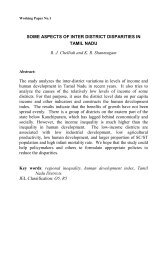
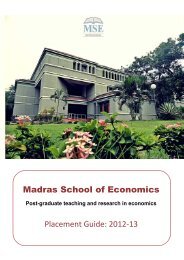
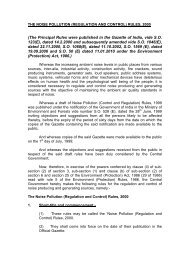
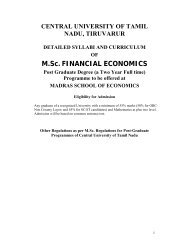
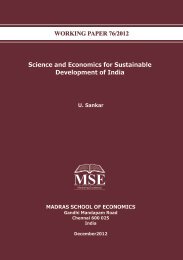
![Curriculum Vitae [pdf] - Madras School of Economics](https://img.yumpu.com/49878970/1/190x245/curriculum-vitae-pdf-madras-school-of-economics.jpg?quality=85)
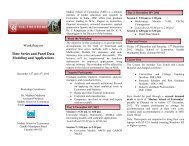
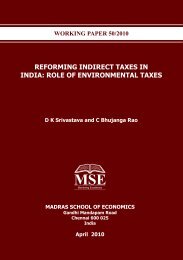
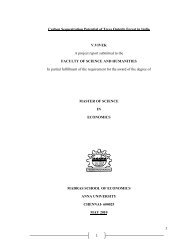
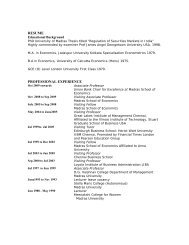
![Curriculum Vitae [pdf] - Madras School of Economics](https://img.yumpu.com/48715201/1/184x260/curriculum-vitae-pdf-madras-school-of-economics.jpg?quality=85)
